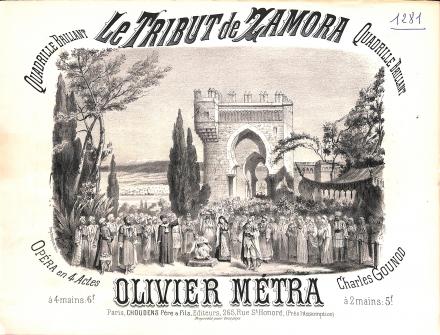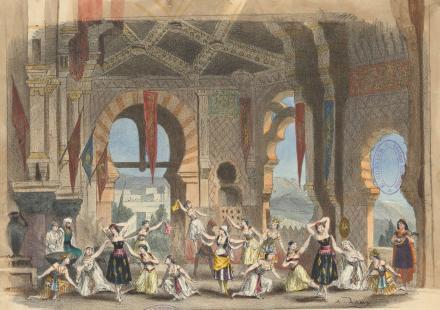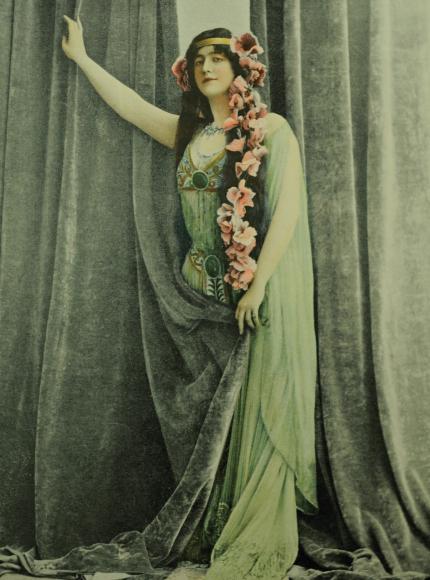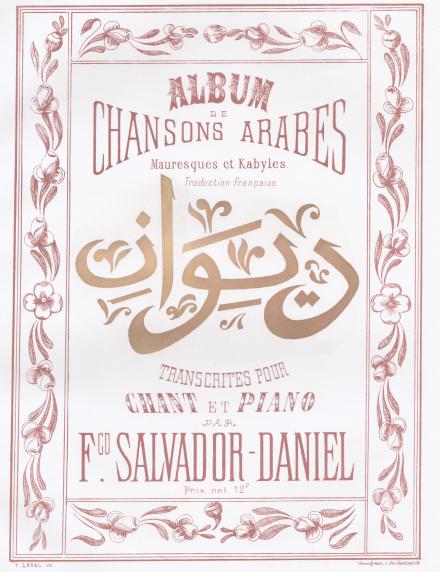Around the world with opera in Paris
In the second half of the nineteenth century, French operas were often set in faraway places, from Spain to the Antipodes, thus catering to the public taste for exotic tales, while at the same time diversifying the pleasure by presenting costumes inspired by a wide variety of sources.

Spain: gateway to the Orient
The French have long been fascinated by the Iberian Peninsula. Whether portraying the Caliphate of Córdoba in the Middle Ages, the Age of Discovery, or southern Spain in the early nineteenth century, the Romantics depicted this frontier region as belonging to another world, sometimes rural, sometimes oriental.

Le Tribut de Zamora
Scene from Le Tribut de Zamora. Act III: In the palace of Ben-Saïd. Design by Pierre-Auguste Lamy.
Opera in 4 acts, first performed at the Paris Opéra on 1 April 1881. Music by Charles Gounod, libretto by Jules Brésil and Adolphe d’Ennery.
Set in Córdoba (Spain).
© Bibliothèque nationale de France

Germaine Bailac as Carmen
23 octobre 1875
Photograph published in the magazine Le Théâtre.
Opéra-comique in 4 acts, first performed at the Opéra-Comique in Paris on 23 October 1875. Music by Georges Bizet, libretto by Ludovic Halévy and Henri Meilhac.
Set in Seville (Spain).
© Bibliothèque du conservatoire de Genève
Find out more
La Sévillane
24 février 1882
Title page of the piano reduction of the overture to La Sévillane. Paris: La Semaine artistique et musicale, 1889. Illustration by Théophile Alexandre Steinlen.
Opéra-comique in 1 act, partly premiered at the composer’s home on 24 February 1882. Music by Cécile Chaminade, libretto by Édouard Guinand.
Set in Seville (Spain).
© Bibliothèque nationale de France

Local colour in opera costumes
While magazines such as L’Illustration, L’Univers illustré and Le Monde illustré were showing their readers landscapes and travel scenes abroad, opera houses began to use sumptuous sets and costumes to whisk their audiences away to foreign places.

Costume designs for La Montagne noire
1895
Costumes for Aslar, Héléna, Mirko and Yamina. Designs by Charles Bianchini.
Drame lyrique in 4 acts, first performed at the Paris Opéra on 8 February 1895. Music and libretto by Augusta Holmès.
Set in Montenegro.
© Bibliothèque nationale de France
Find out more
Marianne Flahaut as Dalila in Samson et Dalila
novembre 1899
Photograph published in the magazine Le Théâtre in November 1899.
Opera in 3 acts and 4 tableaux, first performed in Weimar (1877) and Rouen (1890). Music by Camille Saint-Saëns, libretto by Ferdinand Lemaire.
Set in Israel.
© Bibliothèque du conservatoire de Genève
Find out more
Costume designs for Lakmé
1883
The various costumes worn in the opera by Lakmé. Designs by Stop.
Opéra-comique in 3 acts first performed at the Opéra-Comique in Paris on 14 April 1883. Music by Léo Delibes, libretto by Edmond Gondinet and Philippe Gille.
Set in India.
© Bibliothèque nationale de France
Find out more
Vaslav Nijinsky in Le Dieu bleu
1912
Photograph by Waléry, 1912.
Ballet in 1 act first performed by the Ballets Russes at the Théâtre du Châtelet on 13 May 1912. Music by Reynaldo Hahn, libretto by Jean Cocteau and Federico de Madrazo.
Set in India.
© Bibliothèque nationale de France
Find out more
Madame Galli-Marié (as Vendredi in Robinson Crusoé)
1er décembre 1867
Caricature by Gill that appeared on the front page of the satirical newspaper La Lune on 1 December 1867.
Opéra-comique in 3 acts, after the novel by Daniel Defoe, first performed at the Opéra-Comique on 23 November 1867. Music by Jacques Offenbach, libretto by Hector Crémieux and Eugène Cormon.
Set off the coast of Venezuela.
According to Le Corsaire of 1 December 1867, the costumes were “scupulously faithful” copies of outfits on display at the Musée des Missions étrangères. It is unclear whether the singer actually had to paint her face black in order to play the role.
© Paris-Musées / Musée Carnavalet
Find out more
Lost paradise
The desire to find oneself in different surroundings reflected a need in the West to escape for a while from the upheavals that had taken place, caused by modernity, in the urban landscape, and in life in general. There were dreams of an El Dorado where nature was luxuriant, and of places where women were completely submissive.

La Perle du Brésil
1873
Title page of the piano-vocal score of La Perle du Brésil. Paris: Heugel, 1873. Illustration by Barbizet.
Opéra-comique in 3 acts, first performed at the Opéra-National on 22 November 1851. Music by Félicien David, libretto by Gabriel de Lurieu and Sylvain Saint-Étienne.
Set between Lisbon and the Brazilian forest.
© Académie de France à Rome – villa Médicis
Find out more
La Princesse jaune
Poster for La Princesse jaune. Designed by Charles Léandre.
Opéra-comique in 1 act, first performed at the Opéra-Comique on 12 June 1872. Music by Camille Saint-Saëns, libretto by Louis Gallet.
Set in Holland, where a young man dreams of a Japanese girl.
© Paris-Musée / Musée Carnavalet
Find out more
Madame Chrysanthème
1893
Title page of the piano-vocal score of Madame Chrysanthème. Paris: Choudens, 1893. Illustration by Henri Boutet.
Comédie lyrique in 4 acts, based on the novel by Pierre Loti, first performed at the Théâtre de la Renaissance on 26 January 1893. Music by André Messager, libretto by Georges Hartmann and André Alexandre.
Set in Japan.
© Bibliothèque historique de la Ville de Paris

Colonisation and musical orientalism
In the wake of Félicien David and his opera Le Désert (1844), many French composers drew inspiration for their scores from Oriental melodies. Until the end of the nineteenth century, however, they remained firmly committed to a Western harmonic tradition and subordinated the modality of their borrowings to the system established by the colonial power.

Suite algérienne
1881
Title page of the score of Suite algérienne by Camille Saint-Saëns. Paris: Durand, 1881. Drawing by L. Denis.
In devoting an orchestral suite to Algeria, which he often visited, Camille Saint-Saëns drew on popular local tunes, but he also evoked colonial domination by ending the work with a French military march.
© Bibliothèque nationale de France
Find out more
Ali-Baba
Poster for Ali-Baba. Designed by Lemaresquier.
Opéra-comique in 3 acts first performed at the Alhambra in Brussels on 11 November 1887. Music by Charles Lecocq, libretto by Albert Vanloo and William Busnach.
Set in Persia.
© Palazzetto Bru Zane
Find out more
Paul et Virginie
1878
Title page of the piano-vocal score of Paul et Virginie (Italian version). Paris: Michaelis, 1878.
Opera in 3 acts, based on the novel by Jacques-Henri Bernardin de Saint-Pierre, first performed at the Théâtre-Lyrique on 15 November 1876. Music by Victor Massé, libretto by Jules Barbier and Michel Carré.
Set in Port Louis (Mauritius).
© Palazzetto Bru Zane
Find out more